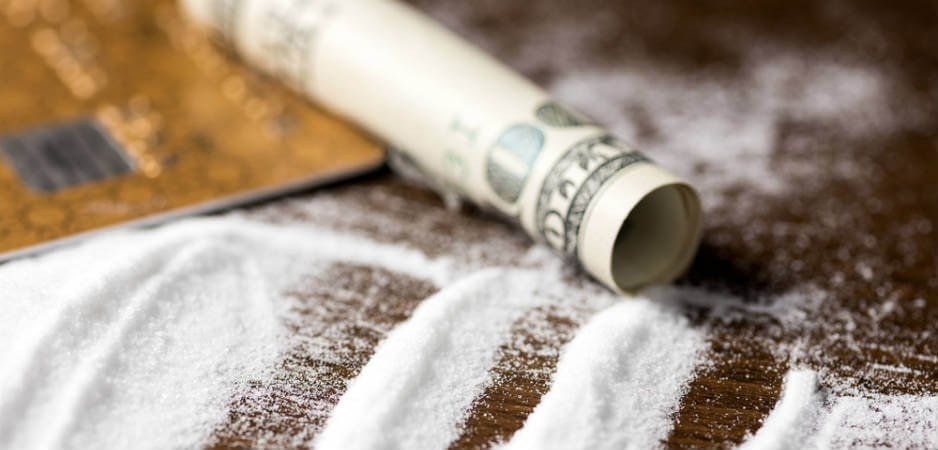Oil-rich and expat-heavy states of the Gulf Cooperation Council have become a major hub and endpoint in cocaine’s eastward expansion.
It seems the world is falling back in love with cocaine. According to the United Nations’ latest World Drug Report, total production in 2015 stood at 1,125 tons, a return to 2008 levels that’s been driven in part by a surge in manufacturing in Colombia. There are currently over 17 million cocaine users worldwide; much less than cannabis, but arguably in line with cocaine’s status as the drug of choice for the rich and famous. Yet there have also been subtle, but nonetheless significant, shifts in regional consumption trends.
While cocaine use is again increasing in its established markets in Western Europe and North America, there are signs that the drug is gaining a foothold in Asia, with the Middle East now accounting for approximately 3% of global consumption. Previous UN reporting also reveals that the region accounted for 39% of Asia’s cocaine seizures between 2009 and 2013. This figure increased to 49% the following year.
Unsurprisingly, the oil-rich and expat-heavy states of the Gulf Cooperation Council (GCC) have become a major hub and endpoint in cocaine’s eastward expansion. None more so than the United Arab Emirates (UAE), which has witnessed an increase in seizures at its airports and interceptions of traffickers that have swallowed liquid cocaine in condoms to escape detection. However, coke’s “arrival” in the Gulf is about more than changing tastes and habits. It is also a reflection of the cartels’ growing business interests in difficult neighborhoods.
“Obvious” Causes
In some respects, the upsurge in cocaine consumption in such an economically important part of the world is to be expected. Just over 25 million foreign nationals are currently based in GCC states, making a contribution to the region’s economy that stretches beyond the corporate world to include the service sector, domestic help and more. Many of these expats bring with them a more relaxed attitude toward entertainment and drug use that are at odds with the GCC’s rulers and religious outlook.
The stakes are undoubtedly high for those that dare to flout the region’s laws and customs. At the beginning of July, UAE authorities prosecuted two British nationals for possessing and supplying cocaine in Dubai. One can expect deportation after his two-year sentence is completed, the other could be facing life in jail. Both will be added to the growing number of people arrested in the Emirates for drug offences, which increased from 173 in 2015 to 391 last year.
It would be naive to assume, however, that the UAE’s hardline approach reflects the entire region’s attitude toward drugs. Given that foreign nationals account for more than 50% of the population in several GCC states, it’s difficult to prevent locals from interacting with expats and participating in social activities. This is particularly true in Bahrain which, following the construction of the King Fahd Causeway, earned a reputation as a weekend hotspot, particularly for the Saudis. Meanwhile in Qatar, where foreign nationals outnumber locals by four to one, officials have warned that between 3% and 5% of the emirate’s indigenous population suffer from alcohol or drug-related problems.
A more troubling development is the use of crack cocaine by Oman’s youth. Following a recent visit to the sultanate, Johan Obdola, president of the International Organization for Security and Intelligence, warns that schoolchildren as young as 12 are using the cheaper and more addictive variant of the drug. This revelation, in turn, suggests that the travails of the GCC’s growing youth population are also contributing to the region’s increased cocaine use. If so, then the drug will have to be factored into state-led efforts to enhance development and employment prospects in a region still reeling from a slowdown in economic growth, austerity and popular unrest.
Familiar Responses
To date, the GCC has relied on tried and trusted methods to combat the spread of cocaine. From a law enforcement perspective, the region’s security agencies seem determined to build upon the Middle East’s growing reputation for tracking and seizing the drug. In April, Saudi authorities seized 46 kilograms of cocaine hidden in a consignment of frozen chicken at King Abdullah Seaport. This was followed last month by the arrest of three smugglers entering the kingdom on Umrah visas. In Kuwait, customs officials followed their recent interception of a drugs pigeon by discovering a consignment of cocaine hidden in wooden pallets.
The Gulf region also continues to benefit from multinational efforts to combat trafficking. These include the Bahrain-based Combined Maritime Forces based out of America’s 5th Fleet headquarters in the archipelago sheikdom. Recent seizures made by its Combined Task Force 150 include the interception of 12 kilograms of cocaine by USS Hue City. The UAE has also played a lead role in international counter-trafficking activities. In response to the Emirates’ warning of an increase in liquid cocaine trafficking, Interpol triggered a purple notice that helped to uncover a transportation route between Ethiopia and the Arabian Peninsula.
GCC states are reacting to the cocaine influx. At the beginning of 2017, Saudi Arabia’s Ministry of Health confirmed that the private sector can now treat and rehabilitate drug addicts in a range of healthcare institutions. Its efforts will eventually be supported by a government-approved treatment plan. At around the same time the UAE was opening its first government-owned rehabilitation center in Dubai. The event was accompanied by assurances that locals and expats seeking rehab will not fall victim to the Emirates’ anti-drug laws.
Given Oman’s problems with crack cocaine (and other substances), it is perhaps unsurprising that the sultanate has one of the GCC’s more robust rehabilitation programs. This is underpinned by a nationwide public awareness campaign and a $200-million government program to build three additional rehabilitation centers. Charity workers warn, however, that the stigma of drug addiction prevents many Omanis from accessing treatment. To some observers, this state of denial also masks the true nature and extent of not just Oman’s drug scene but the entire region’s narcotic problems.
Inertia Creeps
The GCC’s coyness regarding drugs does not end with the cultural mindsets of its citizens. Since his first visit in 2010, Johann Obdola has witnessed a reluctance among security and intelligence officials to acknowledge the full impact that drug abuse is having upon the region. With its clarion call for “better cooperation and unity” and commitment to international cooperation the recently-formed GCC-POL (a GCC-wide Interpol) may yet result in more joined up approaches to counternarcotics. However, transforming laissez-faire attitudes remains a formidable challenge given that most GCC states view Iran as their main security challenge, a point underlined by Qatar’s continued isolation over its ties with the Islamic Republic.
The current lack of “cooperation and unity” between GCC states also clouds their ability to fully comprehend a key motivation behind the cocaine cartels’ growing presence in the region. It’s not just about their ambitions for the new trafficking routes opened between South America and Qatar and the UAE. Neither is it solely to do with the relative ease with which the cartels can transport their product from West Africa to markets in Europe and the Middle East. Mexico’s Los Zetas cartel, Colombia’s FARC and other groups are also interested in investing and washing their profits in the Gulf’s businesses and zero-tax regimes.
Real estate and transportation are thought to be among the prime targets for the cartels’ investment activities. This is hardly surprising given the $2.7 trillion worth of construction contracts currently at the planning or delivery stage across the GCC. The cartels might also be as encouraged by the UAE’s comparatively high placing on the ease of doing business rankings as the Gulf’s downward trajectory on the Corruption Perceptions Index. Transparency International attributes this decline in part to the ruling families’ firm grip on the levers of economic and political power. Either way, conditions on the ground are providing the cartels with opportunities to make their financial muscle discretely felt throughout the Gulf region.
Obdola also highlights the cartels’ no-nonsense approach to due diligence and related business practices. He’s convinced that some of their sharpest minds are now based in GCC states, building knowledge and gaining an appreciation of the local business environment. It is also likely that the cartels are fostering strategic partnerships with the region’s terrorist groups and criminal enterprises. And while hard evidence of interactions is difficult to come by, Latin America’s drugs gangs regularly factor states that are prone to political instability into their business strategies.
Make the Connection
Indeed, the “arrival” of cocaine to the Gulf also suggests that the likes of Hezbollah and al-Qaeda are comfortable with the cartels’ presence in their backyard in much the same way as the cartels tolerate Islamist operatives in their respective patches. The GCC’s security and law enforcement agencies should take note. As stated above, good working relations between the cartels and West Africa’s Islamist groups have facilitated the relatively trouble-free trafficking of cocaine across the continent because of the inability of states to police their customs and border controls. The consequences of a similar arrangement in the Gulf are plain to see: even more cocaine and potentially more revenue for organizations that appreciate the role that drugs can play in financing and facilitating conflict.
As things stand, the GCC’s efforts to tackle cocaine trafficking seem fragmented. It’s the job of GCC-POL to convert member states’ individual efforts and successes into a cohesive and region-wide strategy. The ongoing diplomatic spat between Qatar and the rest of the GCC makes the chances of this happening any time soon remote. No doubt the cartels will be watching how the crisis evolves with great interest. Doing so will help them to shape and refine their regional business interests and criminality.
The views expressed in this article are the author’s own and do not necessarily reflect Fair Observer’s editorial policy.
Photo Credit: hasan eroglu / Shutterstock.com
Support Fair Observer
We rely on your support for our independence, diversity and quality.
For more than 10 years, Fair Observer has been free, fair and independent. No billionaire owns us, no advertisers control us. We are a reader-supported nonprofit. Unlike many other publications, we keep our content free for readers regardless of where they live or whether they can afford to pay. We have no paywalls and no ads.
In the post-truth era of fake news, echo chambers and filter bubbles, we publish a plurality of perspectives from around the world. Anyone can publish with us, but everyone goes through a rigorous editorial process. So, you get fact-checked, well-reasoned content instead of noise.
We publish 2,500+ voices from 90+ countries. We also conduct education and training programs
on subjects ranging from digital media and journalism to writing and critical thinking. This
doesn’t come cheap. Servers, editors, trainers and web developers cost
money.
Please consider supporting us on a regular basis as a recurring donor or a
sustaining member.
Will you support FO’s journalism?
We rely on your support for our independence, diversity and quality.







